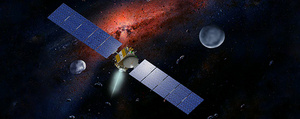LONG BEACH, California -- The public will have to overcome its squeamishness about nuclear power, if current plans for space missions and manned outposts are ever to become reality, industry experts told attendees at the Space 2007 conference this week.
The public's fear of fallout and the government's worries about losing nuclear material have led to onerous requirements in using radioactive sources of power for space probes and to funding cuts for nuclear propulsion research, executives said. Future missions and the creation of outposts on the moon and other planets will require the technology, they added.

|
| ©NASA / William K. Hartmann
|
| Proponents argue that nuclear propulsion could allow space probes, such as the Dawn mission to the asteroid belt, to reach their destinations faster and do more once they get there.
|
"We need to restart development into nuclear propulsion," said Maureen Heath, vice president of Northrup Grumman's Civil Space division. "This is an area where we need to spend more resources to enable the next era of exploration."
Nuclear power and propulsion for spacecraft are nothing new. Since the 1960s, the United States has had the capabilities to launch vehicles powered by radioactive materials. Experiment packages on many of the Apollo missions used nuclear power systems as well. In 2006, NASA shut down most of its research into nuclear propulsion technologies, a project the agency had dubbed Prometheus. The agency had contracted with Northrup Grumman, Boeing and Lockheed Martin to propose future propulsion systems based on nuclear power.
Nuclear propulsion encompasses any technology that uses a nuclear reactor to provide the energy for a rocket engine. The best-known engines are nuclear-thermal rockets, which use nuclear energy to heat a rocket propellant, and nuclear-electric propulsion, which uses the generator to ionize a propellant. Both outperform current chemical-based rockets and are currently under consideration only for spaceflight, not for lifting a rocket from the ground to orbit.
Using a nuclear reactor for propulsion also solves energy problems for missions to the outer planets. Getting power from solar energy becomes increasingly problematic the farther the probe travels from the sun. Nuclear power would allow probes to stay active through planetary nights and not be threatened by any loss of light -- as happened during the recent sandstorms on Mars that almost doomed the two Martian rovers.
"When people go to Mars, there is not enough sunlight" to satisfy the power requirements, said Scott Horowitz, associate administrator for NASA's Exploration Systems Mission Directorate. "You are in a place where you need nuclear."
NASA's latest probe, the Dawn mission to the asteroids Vesta and Ceres in the asteroid belt, uses a solar-powered ion drive for propulsion. By using a nuclear version, the probe could get to the asteroids more quickly and have better and more-powerful scientific instruments, industry experts said.
"Mapping missions that explore multiple celestial bodies like comets, asteroids and moons are made possible by the highly efficient use of propellant that nuclear propulsion offers," Northrup Grumman said in a statement sent to
Wired News. "The available electrical power used for propulsion can also operate vastly more complex scientific instruments and return hundreds to thousands of times more scientific data than other technologies."
Yet, concerns that an accident at launch would expose people to radioactivity have caused some citizens to staunchly oppose the technology. In 1997, public outcry over the use of 73 pounds of plutonium almost scrapped the Cassini mission, a probe which is now delivering stunning vistas and scientific data from Saturn. In 2006, NASA launched the New Horizons mission to Pluto and the outer solar system, but the radioactive material required to power the probe resulted in a lot of political hand-wringing, said Todd May, deputy associate administrator for NASA's Science Mission Directorate, who worked on the New Horizons mission.
"The stack of documents that it took to launch that small amount of plutonium on the New Horizons mission was enormous," May said.
May underscored the public-relations nightmare that the space industry has to look forward to in selling nuclear propulsion to the general population.
"I went down to get a cup of coffee at a cafe before the New Horizons mission, and the lady behind the counter wanted to know what time she should get underneath the table," May said.
Both the Cassini and New Horizons probes get power from a technology known as radioisotope thermoelectric generation (RTG), which utilizes radioactive decay to generate heat and electricity. Most scientists consider the technology to be extremely safe, but more care would have to be taken with a nuclear-powered system.
Because of the concerns, as well as funding cutbacks, NASA has refocused its Prometheus nuclear program to concentrate on creating a power generator that would satisfy the needs of the first lunar outpost. Advancing the technology of nuclear propulsion will have to wait, said NASA's Horowitz. "Right now, it's not in the budget, because we don't have the budget to do it," he said. "But they (the scientists) are working on an important piece, so they are still engaged."
Reader Comments
to our Newsletter